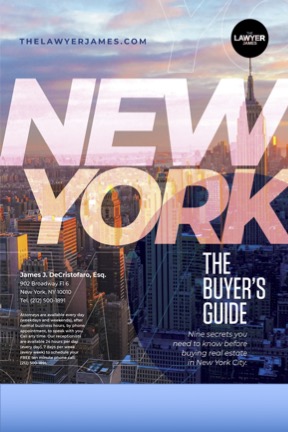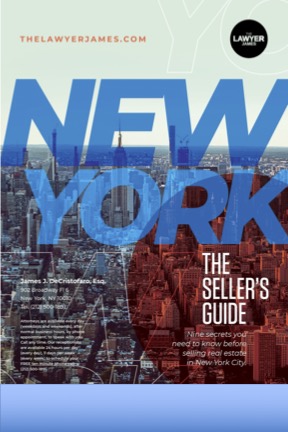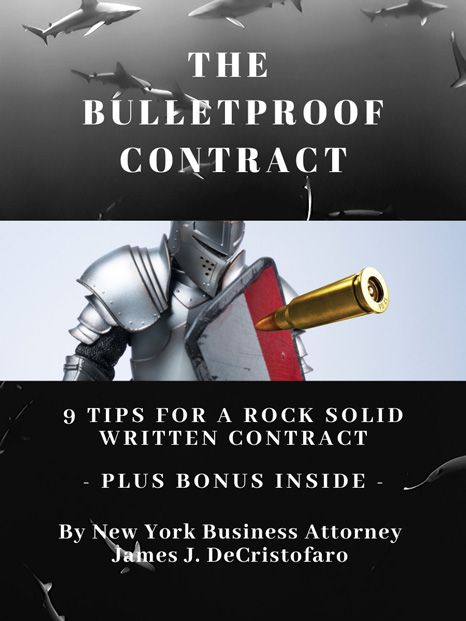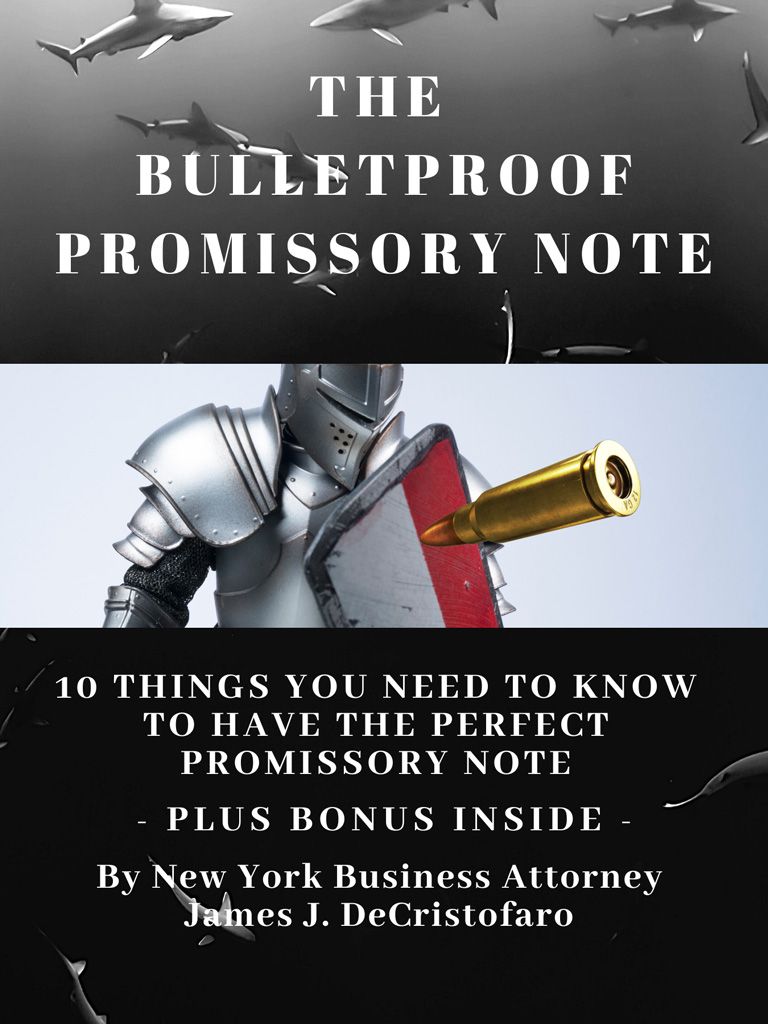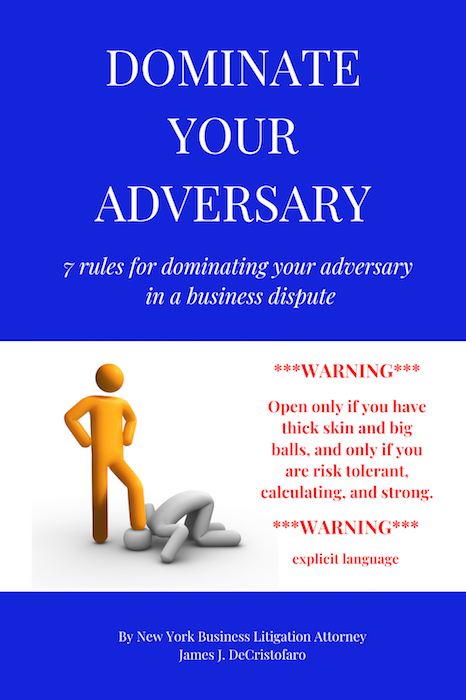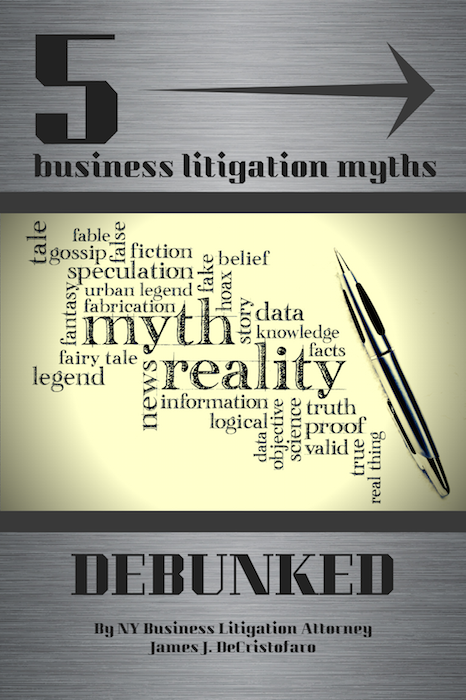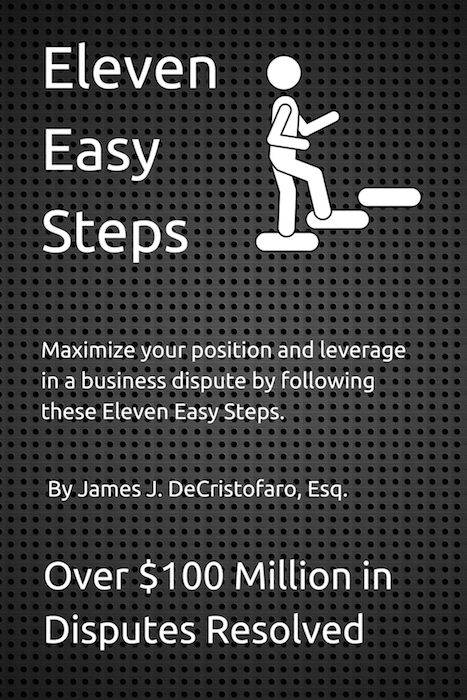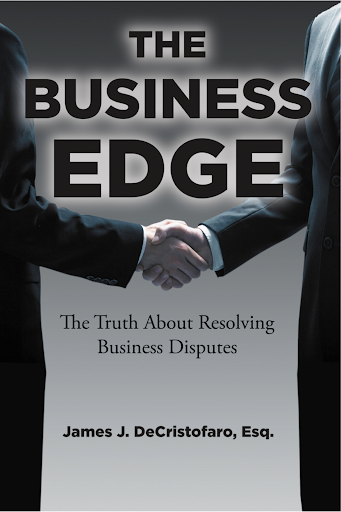Books and Pocket Guides
Books and Pocket Guides
I have published five paperback pocket guides and one hardcover book about my experiences and thoughts as a New York business attorney. They are all available in ebook form below for free.
Pocket Guide: The Buyer’s Guide: 9 Secrets You Need to Know Before Buying Real Estate in New York City
Click Here To Read Excerpt
Secret #7: Know Why You Are Buying.
Ask yourself: why do I want to buy this particular property, at this particular price, in this particular location, on these particular terms, at this particular point in time?
You already know if you are upgrading or downgrading, or if you are starting a new family, or if you experienced a tragic loss, if you have a gain that you need to make a purchase with, if it’s for a parent or a son or a daughter or some other relative, for a short term, a long term, or somewhere in between. You already know this.
What I am talking about is something different. What I am talking about is something that most buyers — new or seasoned — do not know exists, never mind have a good handle on. And that is the between the emotional and the logical.
As I said earlier, emotional purchasing isn’t inherently bad, it just depends on your goal. If your goal is to make an investment that generates financial benefits, then you will need to take emotion out of the picture entirely. It’s not an emotional decision; it’s a financial decision.
To read more of the The Buyer’s Guide: 9 Secrets You Need to Know Before Buying Real Estate in New York City, download the ebook pocket guide here.
Pocket Guide: The Seller’s Guide: 9 Secrets You Need to Know Before Selling Real Estate in New York City
Click Here To Read Excerpt
Secret #5: Remove Emotion from the Sale (if You Can).
Sometimes, removing emotion from the sale is impossible, and this secret is not for one of those times. And what I mean by “one of those times,” there are countless numbers of them, and they include a death in the family, a divorce, a tragic financial event, and so on. Sometimes you cannot avoid being in a sale that is driven by emotion.
There is another emotional sale that is not tragic, and does not typically result in a speedy sale, but the opposite, and that is a sale that involves a nostalgic connection to the property, such as a childhood home or the sale of a home where your grandparents or a best friend lives. For those types of sales, sellers tend to hold onto the property for longer than they should.
The truth is, however, that while these scenarios all can involve emotion, they do not have to involve emotion. How is that possible? You may ask: How can I not want to ever step foot in the house again when my spouse did x, y, and z there? The absolute best way to remove emotion from this scenario and virtually all scenarios is to ask an objective third party that is familiar with the real estate market to help you with the sale, and have you and the market and your buyer determine the price, rather than your emotions. Again, this assumes that you care about the financial aspects of the deal and do not want to leave money on the table, and that you want to get the best deal possible.
The point: know what is driving your decision, because the better financial outcome will be the rational and objective decision, rather than emotional.
To read more of the The Seller’s Guide: 9 Secrets You Need to Know Before Selling Real Estate in New York City, download the ebook pocket guide here.
Pocket Guide: The Bulletproof Contract: 9 Tips for a Rock Solid Written Contract
As a New York business attorney, I have seen countless contracts that are incomprehensible (or, at least, confusing). There are endless business, practical, and legal issue associated with incomprehensible (or, at least, confusing) contracts, but here are two that immediately come to mind . First, an incomprehensible or confusing contract can create an enormous amount of chaos between the parties to the contract. This happens when one party thought it was supposed to do or pay something under one condition, and that condition happened or did not happen or some other condition instead happened and the parties then have no idea what to do. If they cannot work out the issues on their own (which sometimes is possible and other times it is not), then another option is to go to court to resolve the issue, which raises the second issue: you will need to tell the Court what the contract says. If it’s not evident by the language of the contract, you or your attorneys will need to spend endless hours researching and drafting and preparing testimony on what the parties intended, and so will the other side. This could take years and could costs tens if not hundreds of thousands of dollars in legal fees. To help try to ease that pain (and save time and educate the do it yourself businessperson), I put together The Bulletproof Contract: 9 Tips for a Rock Solid Written Contract.
Click Here To Read Excerpt
Tip #1: Do your research.
I want to start by making this point, because it’s critically important: While I recommend doing research, this does not by any means take the place of consulting with an attorney, which — spoiler alert — is the 9th and last tip of this pocket guide. With that said, however, the reason why I am suggesting that you do your own research is so that you can speak intelligently with your attorney, meaning, the discussion will be an advanced discussion because you will already have familiarized yourself with the basics after having done the research; it will make for an efficient conversation. And since your time and the attorney’s time are valuable, the more efficient the better.
With that now out of the way, there are three areas to do your research in: (a) the type of agreement you want; (b) the industry the agreement covers; and (c) the other party or parties to the contract.
Type of Agreement
With all of the resources online, there is virtually endless information available to us, and this information includes information about contracts. And there are all types of contracts, including for employment, construction, real estate purchases and sales, real estate leases, supply, requirements, non-real estate purchases and sales, non-real estate leases, equipment leases, promissory notes and other loans, security interests, prenuptial, post-nuptial, yacht purchases and sales, yacht leases, retainer agreements, service agreements, warranties, financing, factoring, corporate governance (operating agreements), stock purchases and sales, stock options, participation agreements, subscription agreements, car rentals, car purchases, car financing, insurance, and so on. I could go on forever but that wouldn’t serve you. I think you get the point: There are a lot of different types of agreements.
One of my favorites, and it’s not on the list above, is settlement agreements. Why is it one of my favorites? Because those agreements mark the successful resolution of a dispute.
Let me pause for a second before I discuss settlement agreements in more detail, and give you some contextual background. Broadly speaking, practice areas for attorneys fall into two separate categories: First, the practice area where the attorney does not go to court — this is called a “transactional” practice, and a “transactional” practice involves drafting a lot of contracts, drafting reporting filings (like for companies who file reports with the Securities and Exchange Commission), and setting up companies like a limited liability company or a corporation, as well as setting up the corresponding corporate governance documents (think operating agreement); second, the practice area where the attorney does go to court — this is called a “litigation” practice, and a “litigation” practice involves everything that has to do with court. For my practice in particular, I focus on business relationships, so we are talking about civil court (there are other types of courts, like criminal courts, family courts, juvenile courts, landlord tenant courts, and others, but I am not talking about those types of courts in this pocket guide). A “litigation” practice includes appearing in court, arguing motions, attending court conferences, attending court-ordered or voluntary mediation, drafting and filing legal briefs, drafting information demands and requests, taking and defending depositions, and trying cases (and arbitration proceedings).
I have both “transactional” and “litigation” practices, and while a settlement agreement can be used in both practices, it’s most prevalent in a litigation practice, because once you have a settlement agreement, it marks the end of a business dispute; that’s when the parties have reached agreement and have decided to resolve their business dispute.
ACTION ITEM: Research the type of contract you want, review what’s out there, take note of key provisions that apply to your transaction, and discard the ones that do not.
Industry
As you can probably imagine, there are endless industries, from aviation (I am on a plane as I write this section), to automotive, to medical, to food and beverage, to construction, to financial, to … you name it. Again, I will not list the different and endless industries here because it will not serve you. What I will do, however, is point out that there are very likely nuances in the industry that is the subject of your contract that you may not know or may not have thought about. SOLUTION: Research it.
A good example of it is this: I live and work in New York, NY (Manhattan). The local legislature passed a law that outlawed single-use plastic bags as of March 1, 2020. This affects the retail industry the most, and grocery stores, delis, liquor stores, book stores, etc. have to find alternative carry-out packaging. If you owned let’s say a distribution company, and one of your products included retail carry-out packaging, you would want to know about this rule, how it affects the industry, how it would affect the volume of what you are distributing, what suppliers are in that space, how the products will be priced, how they will be stored, who manufactures them, and so on. Why? Because doing so would identify potential risks for you, and you would then use the contract process to minimize or eliminate those risks.
ACTION ITEM: Research the industry that is the subject of the contract, and see if there are new laws or regulations that might affect behavior in the future, or other factors that may identify risks that you can use to minimize exposure and loss with the language of your contract.
The Other Party or Parties
Unless you have a long history of working with a person or company, and even if you do, there’s an enormous amount of uncertainty about performance, payment, quality of product, and so on. One of the greatest things about the internet is that untrustworthy parties are having an increasingly difficult time hiding their untrustworthiness. In many instances, all it takes is a quick Google search to see if the party you are thinking of doing business with (i.e., entering into a contract with) has sued or been sued, what the lawsuit is about, who is at fault, what type of character they have. SIDE NOTE: Just because a person or company is involved in a lawsuit does not mean they are untrustworthy; a lot of times there are legitimate business disputes that need to be resolved, and the business dispute resolution systems we have at our disposal (e.g., the courts, mediation, and arbitration), are perfect for just that. With that said, if a party is repeatedly sued for non-payment and there are bogus defenses, you want to take that into consideration.
Another thing to look for while you are doing your research is the presence or absence of reviews, what type of reviews they are, and what they say. The best and most credible reviews are those by a third-party review service like Google. The absolute best are video testimonials by the other party’s clients, customers, or business partners, and the more, the better.
By doing a basic internet search you can also tell the quality of their work and their attention to detail. I have an excellent example of this. When I first started writing pocket guides a year or two ago, I was looking for a printer to print them. I would visit websites of printers in the United States, and if they were not presentable websites, chances are that their printed product would likewise not be presentable. So I picked the printer with the best website, asked for some samples, and have been working with them ever since. And they’re called Formax Printers — formaxprinting.com. Excellent. Use them if you have a need for printing. And btw, they did not pay for that prop — they earned it, their work is excellent.
ACTION ITEM: Research the other party (or, if more than one, parties) to the contract, look for reviews, the content of the reviews, look for video testimonials, and look at their website to see the quality of their work, which may give you some information you could use in your contract, and importantly, will tell you who your contract counterparty really is.
To read more of the The Bulletproof Contract: 9 Tips for a Rock Solid Written Contract, download the ebook pocket guide here.
Pocket Guide: The Bulletproof Promissory Note: 10 Things You Need to Know to Have the Perfect Promissory Note.
Businesses regularly borrow money privately, and from all kinds of sources of funds, including but not limited to banks, lending funds, factoring companies, merchant advance companies, credit unions, credit card companies, corporate parents or subsidiaries, affiliates, shareholders, and individual and corporate third parties. Lenders typically require a promissory note from the borrower in exchange for lending the money; the promissory note governs the repayment of the money, including the identity of the borrower, the lender, and how and when paid. The promissory note can also contain other sophisticated payment and other terms, that are designed to protect both parties in terms of clarity, and the lender in particular as to risk and protecting against that risk. This pocket guide starts out with introductory terms about contracts generally, then goes on to define what a promissory note is, and then discusses stand-alone versus guaranteed notes, negotiable versus non-negotiable notes, secured versus unsecured notes, payment on a specified date versus on demand, installment payments versus lump sum payments, essential and enhanced terms, lender wants versus buyer wants, and lender’s remedies for breach. Also includes a special bonus: an actual promissory note and a 10 min conversation with The Lawyer James.
Click Here To Read Excerpt
Thing #1: What is a promissory note?
Let’s start with the definition of a promissory note. What is a promissory note? A promissory note is a signed agreement by one party — the borrower, the payor — to pay another party — usually the lender, the payee — a stated sum certain by a specified date or on demand.
You may have also heard of a “loan agreement,” and you may be thinking: what’s the difference between a promissory note and a loan agreement? Succinctly, the difference is the complexity of the document. A promissory note is typically one or two pages long, while a loan agreement is much longer, and usually states, for example, a lender’s recourse, like foreclosure, if the borrower defaults. A loan agreement does not have to be secured, and it can also contain minimum bank balance requirements, and address cross-defaults, i.e., if a borrower doesn’t miss a payment under this loan agreement but misses a payment under another loan agreement, it can be a default under this loan agreement.
To read more of THE BULLETPROOF PROMISSORY NOTE: 10 THINGS YOU NEED TO KNOW TO HAVE THE PERFECT PROMISSORY NOTE, download the ebook pocket guide here.
Pocket Guide: Dominate Your Adversary: 7 Rules for Dominating Your Adversary in a Business Dispute
***WARNING***
Because of the intense and cutthroat nature of litigating disputes in the New York court system as a New York business attorney, and because I have literally been yelled at by judges and adversary attorneys alike, I wanted to show readers just how serious and unexpected interactions both in court and out of court can be, and how to be prepared for those interactions. Although the title of my first pocket guide is Eleven Easy Steps: Maximize your position and leverage in a business dispute by following these Eleven Easy Steps, that guide is a distillation of the interaction on the battlefield, so that you can let me handle that, and you can focus on getting in the proper mindset and getting me the information I need to advocate for you. In contrast, DOMINATE YOUR ADVERSARY has no filter, and tells you how it is, and paints a vivid picture of the realities of litigation and what I constantly face on the front line on your behalf. Here is an excerpt from DOMINATE YOUR ADVERSARY:
Click Here To Read Excerpt
“Rule 1. Understand that your adversary doesn’t give a **** about you.
Think flight or fight, think sink or swim, or think whatever other similar image comes to mind. You’re in the trenches, and there can only be one winner. It’s either your adversary or you who survives, and there can only be one of you. Guess who your adversary chooses? Not you. This is why you need to focus first and foremost on protecting yourself, your interests, and your assets.
There are of course circumstances where it is possible for both sides to resolve their business dispute on a win-win basis, but those circumstances are rare; when they do happen, both sides ink a deal and then afterwards typically walk away thinking either that the other side took advantage of them, or that they could have gotten more out of the deal.
How do you look out for number one and protect yourself? We all have the self-preservation mechanism, so I am not talking about that. Instead, I am talking about being bull-headed and stubborn, at least for now. To do that, identify what you want – your goal, your objective. Is it money? Is it revenge? Is it to minimize your loss? Identifying your goals and objectives is the single most important thing to do because it informs the process.
Next, think about the best way to accomplish your goal. Is it by picking up the phone or sending a text? Drafting a letter or email? Consulting an attorney? Do you turn of service or not deliver your product? Do you not pay? Do you otherwise breach a contract that you have with your adversary? The answers to those questions will depend on your goals and objectives, and the facts of your particular dispute.
Understanding that your adversary doesn’t give a **** about you will allow you to frame your strategy and start out with a rigid, bull-headed mindset. But know this: you may have to change your strategy and pivot later.”
To read more of DOMINATE YOUR ADVERSARY, download the ebook pocket guide here.
Pocket Guide: 5 Business Litigation Myths…Debunked
A lot of clients, whether or not they have been involved in litigation in the NY court system, have a preconceived idea about how the litigation should proceed, and because of that, they need to speak with someone like me, an experienced New York business attorney. Plaintiffs routinely tell me to do one thing or another, and they tell me that if I do that, the other side will roll over immediately and write us a check. In nearly 20 years of practice, that has only really happened one time, but regardless, I will try it every time, on the theory that if you do not ask for something, you will not get it. With that said, it is all about managing and understanding expectations, and in this instance, the issue is that plaintiffs want the case to be decided and paid quickly, while defendants typically do not — there are exceptions, but that is the general way these things go. While a plaintiff may tell me “this defendant does not want the publicity so they will probably settle quickly,” the reality is this does not happen, and it could be for many reasons, including that the relationship between plaintiff and defendant has deteriorated, that the defendant wants to prove the plaintiff wrong and maintain its reputation, or that the defendant just wants to delay. Regardless, most clients think they know what to expect, when regardless of their level of experience in litigation, it is often far detached from what really happens on the litigation battlefield, and as a New York business attorney, I know this to be indisputable. And that brings us to my next pocket guide: 5 BUSINESS LITIGATION MYTHS…DEBUNKED.
Click Here To Read Excerpt
Myth #1: Justice always prevails.
Let me be clear. Our legal system was designed with the best intentions in mind: to achieve justice; to do the right thing; to let the good prevail and to punish the bad; and to be transparent.
In practice, the way that the legal system works and is applied, however, is not what you would think. What it comes down to is this: a set of facts that the judge or jury will see. But be forewarned: just because something happened in real life, doesn’t mean that’s what the judge or jury will see, if they ever see anything at all (i.e., if the case settles there will be no trial).
Let me give you more context so that my point will be abundantly clear, and the best way for me to do that is explain how a trial works from a timeline perspective. There may be other steps, but this is the general timeline overview of how a lawsuit works from start to finish.
First, the party initiating the action (called the plaintiff or claimant) files the initiating papers. In litigation it’s called a “Complaint.” Then the plaintiff or claimant needs to “serve” (i.e., deliver) the Complaint on the defendant or respondent, which starts the clock ticking in the case. If the defendant or respondent doesn’t answer or otherwise respond to the Complaint, the case is subject to default, which means the plaintiff could get a judgment against the defendant without a trial.
There are several steps a plaintiff needs to take to secure a default judgment because, at least in NY, Courts have a strong preference for deciding a case on the merits rather than defaulting a party. We do not need to get into what those steps are at this point. Also, any time I refer to a “claimant” or a “plaintiff” in this section, my reference applies to both, and same for “defendant” or “respondent.” For efficiency I don’t want to keep saying “plaintiff or claimant” and “defendant or respondent”; I will just refer to one or the other.
Second, there is a conference with the Court and the parties to set the deadlines for the case, including discovery, motions, trial, and other considerations.
Third, the parties do their fact digging and prepare for trial. During this time they try to get as many facts as they can from the other side, while at the same time developing their own facts internally. This could take months or years. There could be motions during that time about refusals to provide documents for a variety of reasons, including concerns about confidentiality, trade secrets, privilege, privacy, best evidence, spoilage, and timeliness. There could also be motions about recalcitrant or obstinate parties or non-party witnesses refusing to appear for depositions.
Fourth, the trial. There are three time frames within the trial time period: pretrial, trial, and post-trial. In pretrial, the parties try to see what they agree on, like facts, applicable legal standards, admissibility of evidence, witnesses, the issues to be tried, and logistics. There’s also pretrial motion practice.
During the trial period the parties have opening statements, present evidence through testimony and exhibits, then have the closing arguments.
The post-trial period involves briefing sometimes. And if there is a jury, the jury deliberates and then finds in favor of one party or another.
Fifth, then there’s the appeal, or at least the prospect or possibility of the appeal (if available). This is where the party that lost at trial can have the decision of the lower court overturned or sent back for more questions; at the very least, the appeal is further judicial review, a check and balance should the losing party wish to invoke it.
Here’s the point: if there are ten documents that tell the story in real life, and three of them are inadmissible, then only seven documents get before the decision maker. So, the story that the decision maker sees isn’t always the entire story. It’s like the decision maker has blinders on. And depending on the importance of the evidence that was left out, it could make or break the case. And, if the case goes up on appeal, there is no new evidence — the appeals court decides the case on the record of the trial court, meaning, generally, if it wasn’t in front of the trial court it cannot get in front of the appellate court. There may be exceptions to this, I just don’t know, and I would have to do the research.
In addition, there are countless nuances in our legal system that tend to trip up parties litigating cases. These are commonly and colloquially referred to as “technicalities.” Merriam-Webster defines a “technicality” as “something technical; especially . . . a detail meaningful only to a specialist . . . a legal technicality.” The way I interpret “technicality” is legal procedure, which is separate and distinct from the substantive law. For instance, the substantive law is the law that the judge applies to the fundamental issues of the case, the fundamental “right” and the fundamental “wrong,” and which party is liable and in what amount. On the other hand, if a party does not follow the proper procedure, the judge may not even get to the substantive issues in the case, and the case could be thrown out on a “technicality.” I’ve had this happen several times when representing defendants, and they have been major victories. And this happens because I pay unrelenting attention to detail, while my adversaries are being lazy, careless, or just plain stupid. This could make all the difference in the world between winning and losing.
Here is the takeaway: the party that wins is the one that can tell the clearest, compelling, and most convincing story — with the most credible witnesses — with the admissible evidence. Again, just because it happened in real life, and just because in real life it could make or break your case, it’s not the same thing in litigation. If you can’t get it into evidence and the fact finder can’t see it, then you need to come up with the best story without it. The decision you need to make at that point is do you want to tell the story without that piece, or settle your case. Thus, while the system was designed to do justice for the aggrieved party, justice doesn’t always prevail, and you need to recognize that in formulating your strategy of proceeding with the case or settling it.
To read more of 5 BUSINESS LITIGATION MYTHS…DEBUNKED, download the ebook pocket guide here.
Pocket Guide: Eleven Easy Steps: Maximize Your Position and Leverage in a Business Dispute by Following These Eleven Easy Steps.
Eleven Easy Steps was the first pocket guide I ever wrote as a New York business attorney, which was after I wrote The Business Edge: The Truth About Resolving Business Disputes. I wrote Eleven Easy Steps so that clients who did not want to really know much about legal technicalities but did want to focus on prevailing in their dispute and providing support to me to do that, could stay away from the front line but still be intimately involved, all the while maintaining peace of mind. For some, peace of mind is terribly important because litigation can be unnerving, foreign, unfamiliar, and unforgiving, and someone who would rather focus on maintaining and growing their business would rather be doing just that — and rightfully so — than learning a litigation skill set. Apart from that, in most instances, their value is much greater in maintaining and growing their business than dealing with some sideshow, tangential litigation. That being said, when it is big stakes, bet the farm litigation, and all efforts are directed to the litigation, the litigation can become the business and in that respect, it consumes everyone’s focus. Even so, Eleven Easy Steps provides guidance on eleven helpful steps to show you how to cut through the clutter, get perspective, and maintain composure, based on my experience as a New York business attorney. Here is the first step.
Click Here To Read Excerpt
Step 1. Take a Step Back.
We are emotional creatures. We get pissed when people screw us over. We want revenge. We want those wrongs to be righted. Eye for an eye. Some of us will go to great lengths to get revenge. Sometimes it consumes us. Yet, others take the opposite approach and will ignore the dispute, or the wrong, and move on and not go after what is rightfully theirs. It is entirely up to you how you wish to proceed. The point of this Eleven Easy Step guide is to help you make the right choice.
Regroup. When you find yourself in a business dispute, take the time, and step back, to evaluate the position you are in from a very high-level perspective. This is your starting point. You need to approach this process with a clear head, with an objectively open mind, and not from a position of emotion or hatred. Otherwise, it will cloud your judgment and potentially harm you.
Recognize that the business dispute does not define you. I had a prospective client call me one time to say that he was distraught because he had gotten sued. He was a spectacular craftsman and all he cared about was his craft and his daughter. That is what defined him. And when someone sued him in connection with his craft, he said he felt like his life was going to unravel.
The best thing for him to do at that time was to take a deep breath. He had tens if not hundreds of people he served with his craft, and served them well. He had never had a business dispute before. He could not possibly let one dispute unravel him like that. The crux of the dispute was that because of circumstances outside his control, he was going to miss the project completion deadline – but only by only a few days – so his client sued him ahead of the completion date. To me, the suit was nonsense. To him, it was potentially life-crumbling. Let’s be clear, lawsuits at the end of the day should not mean anything unless and until there is a judgment, and that could take years, and most-likely will never happen because many if not most lawsuits are resolved consensually (i.e., settled out of court), and you need to be prepared to play the game – and stay in the game – until a settlement is reached, or until you get your day in court.
This is not easy. But be disciplined. And at the beginning, take a step back. It will pay off in the long run.
To read more of ELEVEN EASY STEPS, download the ebook pocket guide here.
Book: The Business Edge: The Truth About Resolving Business Disputes
This is the first book I ever wrote as a New York business attorney, and the reason why I wrote it was so that I could provide readers with a practical, plain English description of what the dispute resolution process entails. And it covers a lot of broad topics from mediation, to arbitration, to litigation, to differences between federal and state court, to practical advice about what to do when you find yourself in a business dispute, to ethical considerations, to litigation risk, to different fee structures, to what to expect when you contact my office, to the importance of relationship with adversaries, to the importance of patience, to how working with me is different. One thing over the course of representing many clients is that a lot of them have trouble grasping the process of getting evidence before the decision maker (e.g., a judge) so that the decision maker can make a decision. Clients think it’s obvious, but the issue — and this is really the cornerstone of our judicial system — is that there are two sides in a business dispute, often conflicting; otherwise, there would be no dispute. This may be obvious, but it is often overlooked by clients, even sophisticated clients. For better or for worse, our legal system allows parties to use that legal system to obtain leverage they might not otherwise have. For instance, I represented a single defendant that was sued by a plaintiff, and that plaintiff sued my client and several other defendants. We went into mediation, and the mediator asked me: “Why don’t you recommend to your client that they just pay $X amount to make this case go away?” And I replied: “Because they did nothing wrong, and this case is simply extortion.” Again, for better or for worse, depending on the amount in controversy, it may be more expensive to litigate than to settle. For instance, it may cost you $25,000 in legal fees to get the case disposed, but you could potentially settle it for $10,000. What would you do? The answer to that question depends on your goals and priorities in the context of the business dispute, which is important to discuss, and we discuss that usually during my first call with my clients. But, as every New York business attorney knows, there is another thing to consider when weighing the value of a case, and that is called “litigation risk”; immediately below is the chapter on litigation risk from The Business Edge:
Click Here To Read Excerpt
Chapter 10: Litigation Risk
Litigation risk is the biggest wild card and the most difficult component to evaluate when deciding if you should proceed with the litigation, or hang your hat and settle it. But first, let’s define what we’re talking about: what is litigation risk? It’s the risk that you lose the case, lose a motion, or lose a trial, even when the facts, the law, and everything else seems to be on your side except for the person or people who are deciding your fate (i.e., the judge or jury).
The comforting factor about litigation risk is that every party involved in litigation bears it. So, it’s not a one-sided thing; it doesn’t only apply to you. It applies to all parties across the board.
A real life example of considering litigation risk when deciding to settle is when we represented one of our client’s companies that was owned by a very prominent high-net-worth individual. I was on the phone with his long-time family attorney, and we were discussing the relative strengths and weaknesses of the case, the positions and, yes, litigation risk.
We were very successful at the early stages of the case, but then things started to get more difficult. At that point, we reopened settlement discussions. We attended a mediation, which failed, and then wound up settling after the mediation, on our own.
The family attorney told me that the rationale that drove their decision to settle was this: “James, you know how the saying goes; I can lose a case just as easily as the next guy.” The same is true for winning a case, especially in the business litigation context. Yes, there are good attorneys and bad attorneys, but the good attorneys will tell you that there is always a risk of losing when going to trial, and that’s why so many cases settle.
One thing that’s worth discussing at this point is that attorneys hire or recommend other attorneys, and frequently work together. For example, the high-net-worth individual that I mentioned above probably has a bunch of different attorneys that work for him in different capacities, and deal with different issues. There is usually an attorney that hires other attorneys to deal with discrete issues, like drafting a will, or dealing with family law issues like divorces and child custody. There could be another for real estate issues, another could be an entertainment specialist (for example, if the high-net-worth individual were in the entertainment industry), and, of course, another could be one to handle business disputes, like DCL Firm (DeCristofaro Law).
In another case, we had a different high-net-worth client who refused to settle, in part on principle, and in part on assessing the value of the risk. From a legal perspective, the risk was all over the map, and the outcome was difficult to predict.
So, we diagrammed out the known risks and the unknown risks, and assigned values to the unknowns. At that point, we identified the risk associated with the unknowns, eliminated some of them from a business or probability perspective, and then identified the remaining portion of the risk. At the end of the day, the client simply was not willing to pay the settlement price the other side was asking for to make that risk go away, and he chose instead to take his chances. As it turns out, we won, but we were just as likely to win as lose; that’s the whole point of litigation risk.
One thing to consider is the level of confidence that you have in your chosen law firm, that it will be the best advocate for you and represent your interests thoroughly. If you do not, then your risk of losing goes through the roof, and so does your stress level. Make sure you are comfortable with your attorney; if not, get a new one. It will balance your litigation risk, and your stress level.
In essence, litigation risk is something that every single business owner—and every individual—involved in litigation needs to fully understand. There are no guarantees.
It just might turn out that the judge takes an entirely different view to what would appear to be the legal, business, or practical merits of a case and to what was anticipated by counsel or the parties. Perhaps the judge is just having a bad day. Who knows?
This is not to say by any stretch of the imagination that judges are biased; rather, it is to recognize that judges are human, too. And sometimes they make the right decision and sometimes they make the wrong decision (depending on your viewpoint, I guess), and that is what the appellate process is for. But that could be a completely different book.
The courtroom is an unpredictable environment. My experience litigating cases in many different jurisdictions and forums is that you don’t know exactly what’s going to happen—unless and until it happens.
For example, in a large bankruptcy case we were working on, we had to shut down a handful of company offices in different international jurisdictions. To shut down one of the non-U.S. offices, we had to get the Bankruptcy Court’s permission to make a substantial payment, which did not normally comport with the priority payment structure of the U.S. Bankruptcy Code.
The problem was that if we did not make that payment, there could have been severe consequences for the officers and directors of the bankrupt company. We came up with a very practical and creative solution by applying a provision in the U.S. Bankruptcy Code that would allow the judge to authorize the payment. Going in to the Bankruptcy Court that day before the judge, we had no idea if he was going to grant our request or not. We made our best argument, we were supported (or not challenged) by the other interested parties in the case, and in the end, the judge granted our request. In this instance, it was not really a choice; the client had to go for it.
That was a unique situation, and there is a different type of risk under those circumstances, but it is nevertheless a risk. The more aligned litigation risk is where we file a motion or a claim, it gets opposed, and it goes to the judge for a decision. We have taken very aggressive positions before with a small chance of success, and we have prevailed. On the other hand, there are situations where the facts and the law are on our side, but the judge doesn’t agree. As I said earlier, it’s a wild card, and it depends on a particular client’s appetite for risk, and comfort with their law firm’s advice and abilities, and ability to communicate.
You can always assign a probability of a case going one way or another based on experience, but you just never know. Some clients want to take that chance; others do not. Again, we will be the best advocates either way, as it’s ultimately the client’s decision on how to proceed.
To read more of The Business Edge, download the ebook pocket guide here. [ORDER FROM AMAZON https://www.amazon.com/Business-Edge-Truth-Resolving-Disputes/dp/148356603X; ALSO AVAILABLE ON KINDLE].

